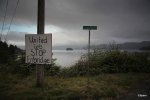Protest
For the past few weeks I have posted about my trip to Haida Gwaii (formerly known as the Queen Charlotte Islands). The trip included some time in Charlotte (or the Village of Queen Charlotte to use its full name). A prominent feature of the main road in Charlotte and east to Skidegate (as far as I went) are the signs protesting the proposed pipeline that would bring, every day, 550,000 barrels of oil from the Alberta tar sands to a proposed loading facility at Kitimat on the mainland shore due east of Haida Gwaii. The pipeline would result in large numbers of ships taking oil to the Chinese market and bringing back the condensate (about 200,000 barrels a day) used to help the oil flow in a pipe. The condensate would return in a parallel pipeline back to Alberta. There has been a moratorium on tanker traffic in Hecate Strait for decades and people remember vividly the scenes from the Exxon Valdez oil spill further up the coast in Alaska, the effects of which are not yet over (for instance, the survivors of one resident pod of Orcas stopped reproducing and is expected to die out in the next few years).
I was well aware that people on the north coast were opposed to this proposed development. But, I had no idea as to the depth and breadth of their feelings. These signs were everywhere, bumper stickers are common, I overheard people talking about it in restaurants each time I was in one, the crew talked about it on the project many times, the director of the museum made sure I knew about a great stop-motion video produced by some young Haida in protest (embedded below). Everywhere I went people are opposed to the development and I never heard anyone speak a single positive word. This was very striking and the first time I have found a uniform opposition to development in BC. I wonder if the politicians really understand how much trouble they will have on their hands if this thing is approved. It seems likely there will be a big political price to pay.
It is timely (and probably not coincidental) that Elizabeth May (now an MP for the Green Party) re-published her book Paradise Won: The Struggle for South Moresby free and on-line that chronicles the politics behind establishing the Gwaii Haanas national park in the late 1980’s – it is very well written and worth a read, especially as it shows some of the unexpected ways that politics get done behind the scenes.
There have been many public hearings run by the National Energy Board, and they seem well attended. Kilgii Gwaay crew member Gwaliga spoke at one of them, and his thoughts were on-line, but the website seems broken as I write (so my plans to link to that document are stymied). All of the coastal First Nations communities have made their concerns known at the hearings and in submissions to the NEB. Some of them include concerns about the effects (large file download) on intertidal and near-shore archaeology that could arise from coating them in oil, and then removing it, or letting it seep into the sites, or just from having workers in the area exploring on their breaks to find burial caves and that kind of thing. The Gitxaala First Nation have commissioned various expert testimony in their submissions. One submission analyses the challenges mariners face navigating the 160 mile long confined channel waterway through which the tankers must pass when leaving Kitimat just to get to Hecate Strait. If you only read one of the links in this post, read this one for a sense of why people are so determined to not allow this development to proceed. The report points out that this will be the longest escort-style transit for ships anywhere in the world. That report, by an experienced master mariner concludes: “I believe it is not a question of whether or not there will be an accident and pollution due to an oil spill but rather the question is when will there be an accident. Any tanker is controlled and propelled by machinery and that machinery is operated by humans. Machinery can and will fail and humans can and will make mistakes.” This opinion is backed up by a reasoned argument concerning the length of passage, the lack of anchorages, the narrowness of the channels, the nature of the vessels involved and other pertinent analysis. Even if only some of the report is pertinent and correct, then the conclusion seems justified.
And Hecate Strait is the location of some if the worlds tallest recorded wave heights of over 100 feet, which occur unexpectedly when waves are already large. One documented example is where the waves are maxing out at 40 feet, with the unexpected arrival of one nearly 2.5 times as large – ref). Submissions to the NEB such as this one, which is presumably prepared for the proponent, or other pro-development submitter, contain further clues as to why people are frustrated and concerned. This report uses the statistic “significant wave height” which is “The average of the one-third of the largest measured waves, usually computed over a period of one hour or less.” It does not mention the unusual extreme waves which are probably the ones most likely to contribute to an accident rather than the more normal expected conditions (severe as they can be). A report prepared in relation to another hot issue, the possibility of oil drilling in Hecate Strait, says “The strong winds in the Hecate Strait generate considerable waves and swells. … During storm events the sea state can increase to over 10 m. Waves of 20 – 30 m have been recorded in the strait. Of particular concern is the rapidity with which the seas can increase, often within hours.” Like so many of these studies, the analysis focuses within the 90 or 95 or even 99.5% events, the once in 100 years or 200 years probabilities (usually generated from observations taken over a couple of decades). This approach is a cause of local concern because people expect that accidents will occur, they are sure that the other 5% or 0.5% is going to happen during the life of the project.
The island residents who have all spent time on the beaches in this area, or on the water observing the wildlife, or fishing, feel keenly the potential catastrophe of an oil spill. They find it impossible to believe that a delicate ecosystem like the one that repeatedly shows up in my posts of the past few weeks, especially this one, could survive a coating of oil and the subsequent cleanup activities.
EDIT: I forgot to embed this video. Hope you find it amusing, and artful:
To launch the gallery view click on any photo, use the arrows to navigate between images and press escape to return to this page.
- In front of the breakfast restaurant
- To the west, Skidegate Channel
- View from the restaurant
- At the float plane dock
- At the ball field
- At the float plane dock
Canon 5Dii, Canon 50mm/f1.4 and Nikkor-N 24mm/f2.8 lenses, mostly ISO 200, some at 100, others faster.
.
.





















As always, what a great and very informative post…thank you so very much for sharing.
LikeLike
Thanks David – this is a huge topic with a ton of coverage already – just nibbling at the edges of it. I had a conversation with someone yesterday that has been spending time in central BC near where the pipeline will pass, and they told me that the area is also consumed by this matter, with it being nearly the only topic of conversation.
LikeLike
This is a hot button topic, one that is near and dear to my wife and I. What a well written piece on this conundrum, Ehpem. I hear our premier using strong language, but remains uncommitted in regards to doing the right thing. We can only hope that many people get to read your blog here, my friend, and will bring their voices to bear on this situation and maybe as a community we can turn this all around…
LikeLike
Thank you Toad. It is a matter of concern for many people in southern BC too, but my impression is that on the North Coast concern is too mild a word – feelings are very strong and very deep.
LikeLike
Pingback: Great Bear Rainforest « If you would not be forgotten
Hi, I forgot to embed the promised video. I have done so now, if any of you are following comments
LikeLike
As you know this is something I learned about through my daughter who learned about this in her forestry class. It is important that people do anything and everything they can to stop this. Look at En bridge’s record….it stinks. I live in Ontario so I cannot actively participate in protests but I encourage people to do what they can: contact politicians (tell them that shortening the time for the approval process for projects like this will cause irreparable damage to our environment and our future and the way of life of entire cultures); look at any investments you have and get out of the tar sands and the oil and gas industry! thank you for using your post to bring forward this struggle.
LikeLike
Hi Paula. If you have not read Elizabeth May’s book that I link to in the article, you might find it interesting. It illustrates that things that are of national concern do give an effective voice to people whose ‘backyard’ is not involved. I do wonder if this pipeline is being used as a bit of a political stalking horse. There are many things going on out here such as other pipelines and pipeline upgrades, numerous coastal LNG plants and so on which are getting no press, or very little.
LikeLike
Great post. I feel like this is a repetitive theme in societies all over the world…until there is a shift in resource demand, there will continue to be “not in my back yard” arguements.
LikeLike
That is so so true. Until demand slows down, there are alternatives to using the tar sands oil that run less risk of hugely catastrophic events – it could be piped around the North American continent for refining and use more locally, which would then reduce the number of tankers bringing oil to North America, and those supplies could be run shorter distances, such as to China.
LikeLike
Your article on the pipeline, the dangers to tanker traffic there and the local population’s concerns is one of the best exposures I have come across.
LikeLike
Thanks Joseph. There is a huge amount of information available about this, but it is pretty hard to dig out.
LikeLike